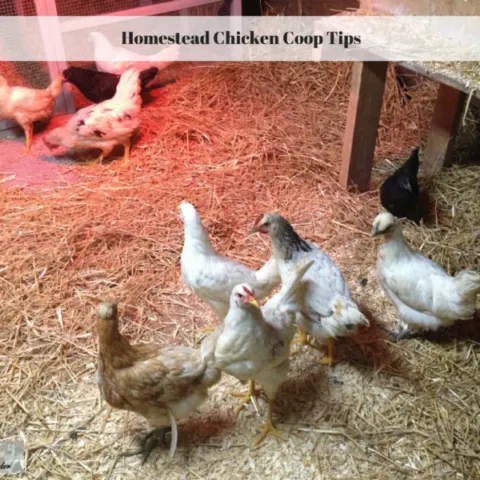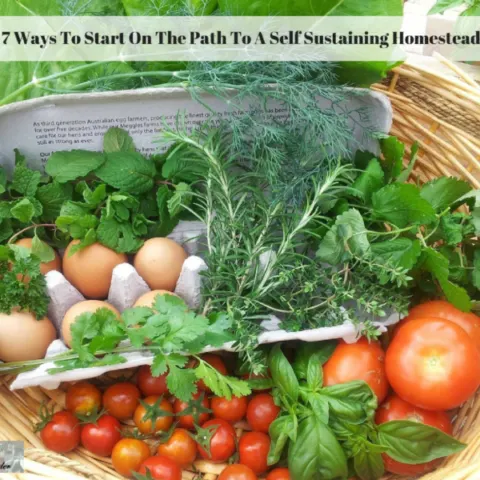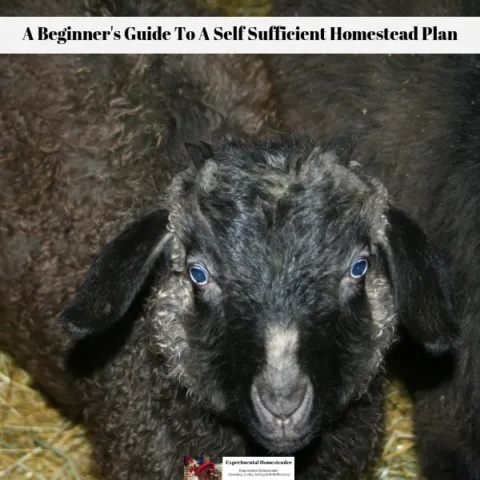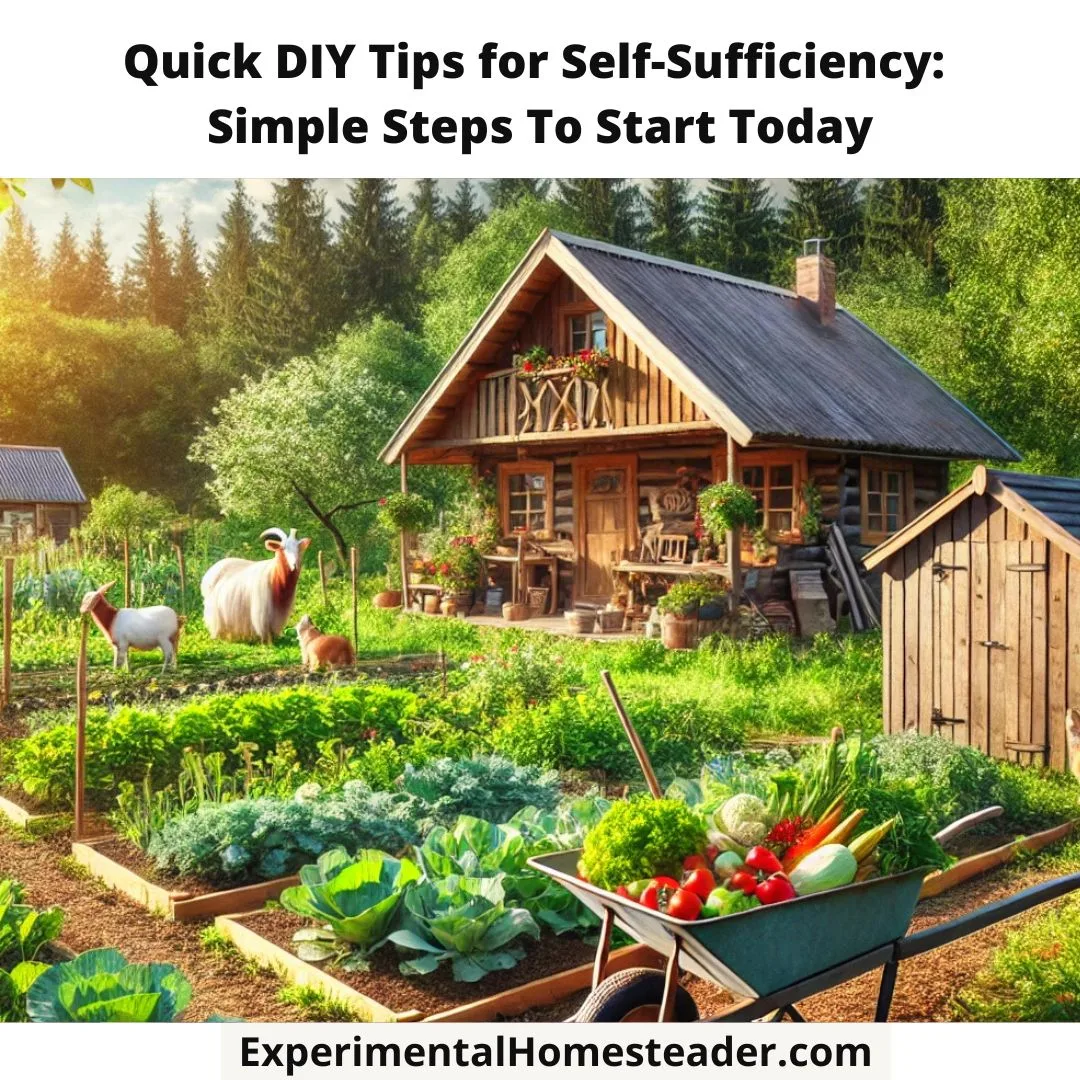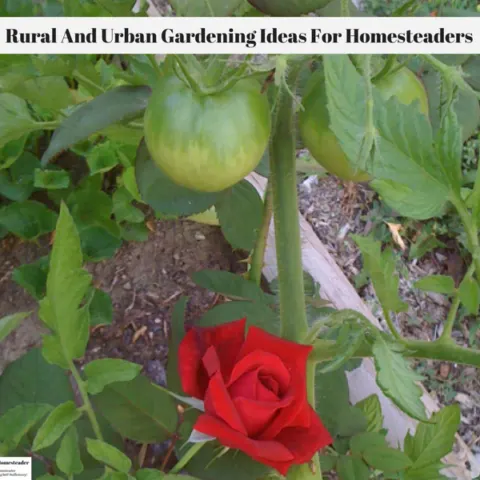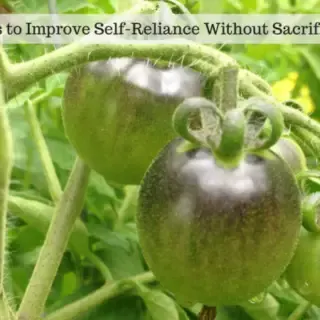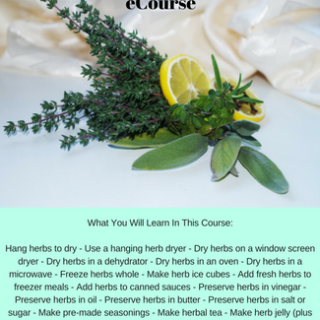Homesteading skills and crafts are at the heart of this timeless way of life, offering a bridge between our ancestors' wisdom and the needs of our modern world.
Homesteading is a journey filled with rewarding challenges and beautiful simple pleasures, an age-old way of life that is making a resurgent comeback in modern times.
It's an enticing call to return to nature, where humans reclaim their primal instincts and learn to live off the land, producing their sustenance, tending animals, and mastering traditional crafts.
This evocative lifestyle underscores the core principles of self-sufficiency, resourcefulness, and resilience in the face of life's unpredictable turns.
To fully embrace the world of homesteading, you need to hone your homesteading skills and crafts.
These encompass everything from food production and animal husbandry to craft mastery and emergency preparedness.
Whether you're nurturing a flock of chickens, crafting homemade soaps, or learning how to preserve food, each skill and craft is a step toward self-sufficiency and a deeper connection with the land.
So, let's embark on this journey together, delving into the world of homesteading skills and crafts.
By mastering these timeless arts, we can embrace the conveniences of modern life while staying true to our primitive roots.
Homesteading is not just a way of living; it's a way of thriving in harmony with the world around us.
Gardening & Food Production Skills for Successful Homesteading
No true homesteader would deny the unmatched satisfaction that comes from enjoying a meal born from their own land.
But to reach that point, it takes more than a simple love of the outdoors and a desire for self-sufficiency.
It requires a multitude of gardening skills and food production know-how.
Perfecting these core skills can set you on a rewarding path to sustainable living, offering fresher food, healthier lifestyle and even a buffer against economic instability.
- Soil Conditioning Skills Healthy soil is the lifeblood of any thriving garden. It's much more than mere dirt; it’s a vessel of nutrients for plants. Successful homesteaders understand the value of regular soil testing and adjusting the pH levels accordingly. They also know how to select and use the right soil amendments - be that manure, compost, or bone meal - to ensure the soil nurtures each plant appropriately.
- Knowledge of Seasonal Planting Timing is everything in gardening. Homesteaders must develop a strong sense of when to plant and harvest each species for peak freshness and growth. Awareness about plant hardiness zones and seasonal frost dates can provide a starting point for this intricate understanding.
- Symbiotic Planting and Crop Rotation Symbiotic planting involves pairing crops that benefit one another — for instance, carrots and tomatoes or corn and beans. Furthermore, homesteaders also practice crop rotation – switching plant locations each season to prevent soil exhaustion and disrupt the lifecycle of pests and diseases.
- Seed Saving Successful homesteading often hinges on a keen thrifty spirit. Saving and storing seeds from one season’s plants can not only reduce costs but also ensure a resilient, self-perpetuating garden. Plus, you’ll have the satisfaction of growing plants entirely from your own stock.
- Pest and Disease Management Identifying and combating the various insects, fungi, and diseases that can sweep through a garden takes time and practice. Homesteaders gradually build a knowledge base of reliable natural and organic methods for pest control, ensuring a healthier, chemical-free bounty.
- Preservation Techniques When it comes to food production, the skills extend beyond just growing the food. It’s equally essential to master the art of food preservation. Whether it's canning, freezing, drying, or pickling, these techniques ensure homegrown produce is available year-round, reducing reliance on store-bought goods.
- Animal Husbandry Many homesteaders choose to raise animals for eggs, meat, or even dairy. This requires a fundamental understanding of animal care, including feeding, breeding, and disease prevention. Depending on the specific animals, additional skills, such as milking or shearing, may also be necessary.
- Foraging Practice Foraging can supplement a homesteader’s diet with a diverse range of wild edibles. This requires a keen eye for distinguishing safe from poisonous plants and an understanding of sustainable harvesting practices.
Mastering these skills doesn't happen overnight, it's a journey taken step by step to a more sustainable lifestyle.
Roll those sleeves up, get your hands dirty, and embark on an incredibly rewarding adventure of successful homesteading.
Here's to a warm sunrise, rich soil, and the peace of realizing food doesn't always come from a supermarket aisle.
Nurturing Livestock: A Comprehensive Guide for Homesteaders
Building up a homestead from scratch can certainly be a daunting task.
But once you've got your soil conditioned, your crops steadily rotating, and your pest control mechanism in place, it's time to take one step forward.
It's time you ventured into the exciting world of livestock care and management!
Evolving from a novice homesteader to a seasoned livestock keeper demands patience, dedication, and, most importantly, knowledge.
Fortunately, acquiring those skills can be a rewarding journey.
Let's dive into some essential aspects of livestock care that every homesteader should be familiar with!
First things first, selecting your livestock is critical.
Each animal species offers a unique source of profitability, whether it's milk, meat, eggs, or wool.
Poultry, including chickens and turkeys, are quite easy to care for and yield highly sought-after produce.
Cows and goats can provide milk, meat and fiber, while sheep offer wool, besides the meat.
Then there are pigs with a knack for natural plowing and turning up the soil.
Think about what your homestead needs and choose appropriately.
Knowing your animals' needs is essential for their well-being.
Provide them with the necessary diet, comprising a balance of grains, greens, and protein, based on the species.
Remember, the feed quality directly influences the quality of the produce.
A cow fed on high-quality hay, for instance, will yield more nutritious milk.
A key step in managing livestock is providing adequate shelter.
While some animals are more tolerant of weather extremes, others might need a warm, cozy barn or a cool, shaded area.
While a milk stand is not a necessity for goats, it sure is nice to have one.
The shelter should be spacious enough for all animals with plenty of ventilation and reasonably easy to clean.
Regular health checks are another must in a homesteader's routine.
Monitor your livestock for signs of disease and address any issues right away.
Vaccinations and deworming should be part of their periodic healthcare regime to avoid any large-scale outbreaks.
Remember, happy animals mean a happy homestead.
Consider animal welfare and enrichment as integral parts of your routine.
Everything from a scratch behind the ears to room for movement can contribute significantly to an animal's mental and physical wellbeing.
Don't overlook the power of proper fencing and secure gates.
Strong enclosures will not only provide protection to your livestock from predators but also prevent them from venturing stray, causing potential devastation in your plantation.
Managing livestock manure is a homesteading silver lining you shouldn't miss.
While it can be a bit of a 'dirty job', turning manure into compost is a big boon for your plants.
Keeping a dedicated area for manure composting not only helps in waste management but also aids soil fertility in the long run.
In conclusion, efficient livestock care on a homestead involves both holistic and detailed understanding.
Your foray into homesteading has already provided a robust foundation.
Take that knowledge, apply it to livestock management, and see your homestead flourish in ways you didn't imagine before!
Traditional Homesteading Crafts & Trades
Diving deeper into traditional crafts and trades that can greatly enrich a homesteader's experience while keeping the budget balanced, let's uncover more hidden and timeless treasures.
- Woodworking: Mastering the basic woodworking skills opens the doorway to endless possibilities. It's a time-honored craft that can significantly reduce the cost of homesteading. Think about all the basic farm structures you can construct out of wood - from small nesting boxes for chickens to large barns for cattle, and not to forget beautiful handmade furniture for your home. By salvaging and repurposing wood, a homesteader can both conserve resources and cut down on expenditures.
- Blacksmithing: Blacksmithing might seem like an ancient craft, but it couldn't be more useful on a homestead. Whether you need to mend a broken gate, fashion a new hinge, or forge sturdy tools - blacksmithing has got it covered. Homemade tools often outlive their store-bought counterparts, saving you money in the long run. Investing time and effort in learning blacksmithing offers not only practical benefits but delivers the satisfaction of physical creativity.
- Beekeeping: Honey and beeswax are superb homesteading resources with a myriad of uses. Propagating honeybees hosts a plethora of benefits for ecosystem balance, ranging from pollination to honey production and more. Honey can be used for its sweetening properties or in an array of homemade health and beauty products, while beeswax finds its use in candle-making and furniture polish. Beekeeping does require some initial investment but the subsequent rewards over time far outweigh the costs.
- Candle and Soap Making: Handmade candles and soaps add a personal touch to a home and serve as cost-effective gifts. Moreover, they eliminate the reliance on store-bought chemical-rich versions, enabling a healthier lifestyle. Leftover kitchen fats can be detoxified and used for soap-making, while beeswax (from your newly introduced bee farm) can be used for candles. Learning these skills is a worthy investment that saves money and fosters self-sufficiency.
- Cheese Making: If you're into dairy farming, cheese making is an excellent skill to acquire. It not only adds variety to your pantry but can also provide an income source if sold at local markets or to neighbors. Cheese making is an art form that allows you to experiment with different flavors and textures, transforming ordinary milk into culinary delights.
- Spinning and Weaving: Knowing how to spin and weave can significantly cut down clothing and textile expenses while allowing the creation of unique designs. With wool from the resident sheep or fibers from plant sources such as cotton or flax, a homesteader can spin yarn and weave it, producing everything from winter blankets to summertime attire.
Remember, every mastered skill is another step towards self-reliance and sustainability.
While these crafts and trades may seem outside the realm of the modern world - on a homestead, they are treasures to be rediscovered, activated, and celebrated.
So, get those hands working and the creative juices flowing - the vast world of homestead-enhancement awaits!
Energy and Resource Management
- Frugality and Resourcefulness: Understanding the principles of frugality and resourcefulness is vital for successful homesteading. This encompasses everything from repurposing old items, to mending clothes instead of buying new ones, reducing waste, and making the most out of every resource.
- Woodworking: Mastering the basics of woodworking can save a substantial amount of money for homesteaders since they can create and mend items such as fences, furniture, and storage structures themselves. Not only does this encourage self-reliance, but it also cultivates creative skills.
- Rainwater Harvesting: Rainwater harvesting is a valuable and eco-friendly technique that reduces water dependence on external sources. It encourages water conservation and provides an alternative water source for irrigation and livestock that is free of chemicals and additives.
- Basic Home Repairs and General Maintenance: The knowledge to fix basic home issues such as leaky taps, broken tiles, or faulty electrical outlets empowers homesteaders to maintain the homestead without always relying on experts.
- Charcoal Making: Creating charcoal at home is a handy and useful skill. The charcoal finds use in cooking, heat production, and improving soil quality.
- Understanding Local Ecosystems and Biodiversity: Gaining knowledge of local fauna, flora, and ecosystems can provide an advantage in managing a homestead. It aids in implementing efficient planting, foraging, and pest management strategies, and contributes to maintaining ecological balance.
- Soaps and Candle Making: Most homesteaders opt for making their own soaps and candles. This allows for cost savings, the creation of all-natural products devoid of harmful chemicals, and an opportunity for creativity.
- Composting: Effective composting plays a significant role in creating a sustainable loop of productivity on a homestead. In addition to mitigating the impacts of waste, it enhances soil fertility which in turn aids in healthy, bountiful crop production throughout the year.
- Hot Bed and Greenhouse Construction: Designed to harness the sun's warmth, hot beds and greenhouses can elongate growing seasons, protect tender plants, and enhance crop productivity. Learning these construction skills ensures year-round cultivation and a continuous supply of fresh produce.
- Homemade Dairy: Making your own homemade dairy products, such as cheese, yogurt, and butter, reduces reliance on store-bought items, saves money, and permits control over the ingredients used.
- Wine and Mead Making: Wine and mead making can be a delightful hobby, producing fantastic beverages to enjoy and share with others. It's a creative and enjoyable process that can turn excess produce into something truly special.
Embracing these various skills and techniques not only diversifies the homesteading experience but also boosts self-reliance, sustainability, and connection with the environment.
Each capability contributes to the successful management of energy and resources on a homestead fostering a fulfilling and sustainable lifestyle.
Emergency Preparedness & Survival Skills
Understanding the principles of frugality and being resourceful can go a long way in making a homestead more self-reliant.
Resourcefulness involves finding innovative ways to use available resources, and frugality focuses on strategic spending, both of which are invaluable for stretching limited resources in times of need.
- Fire Making: The ability to start a fire is fundamental for survival. Whether it's for warmth, cooking, or signaling for help, knowing how to build a fire from scratch is a cornerstone skill. It connects you to our ancestors who relied on fire for countless purposes.
- Foraging: In an emergency, knowing which wild plants and fungi are safe to eat can be a lifesaver. Foraging skills allow you to identify edible vegetation in your local environment, providing an additional food source when needed.
- First Aid and Medical Skills: Being prepared for injuries and illnesses is vital. Basic first aid and medical knowledge can make a significant difference in critical situations. From treating minor cuts to handling more serious injuries, these skills are invaluable.
- Navigation: Understanding how to navigate using maps, compasses, or even natural landmarks can be a game-changer in a survival scenario. It ensures you won't get lost and can find your way home or to safety.
- Preserving Food without Electricity: When the power goes out, knowing how to preserve food without refrigeration is a must. Techniques like canning, smoking, or dehydrating food can help you stock up for the long haul.
- Wildlife Awareness: In an emergency, understanding local wildlife and their behaviors is crucial. It helps you avoid potential dangers and can also be a source of food if hunting is necessary.
- Natural Shelter Building: Sometimes, you might need to quickly construct a shelter. Learning how to create a basic, weather-resistant shelter using natural materials is an essential skill for survival.
- Water Purification: Clean drinking water is non-negotiable. Knowing how to purify water from natural sources, such as rivers or rain, can ensure your hydration needs are met safely.
- Communication: In emergency situations, effective communication can be a lifeline. Knowing how to use radios, signal devices, or even basic Morse code can be vital for seeking help or staying in contact with others.
- Self-Defense: Unfortunately, self-defense skills may be necessary in some survival scenarios. Learning basic self-defense techniques can help you protect yourself and your homestead.
Embracing Homesteading's Rich Tapestry
The art of homesteading is an adventurous pursuit that folds into its fold a tapestry of skills, experiences, and life-altering challenges.
It's a call to a life of self-sufficiency, a life entwined closely with nature and its intrinsic principles.
Whether it's the triumph of harvesting your first crop, the joy of witnessing a new life in your livestock family, the pride in crafting everyday amenities with your hands, or the relief and confidence in being prepared for the unexpected, every facet of homesteading instills an empowering sense of accomplishment.
Entrenched in this unique mosaic of experiences, one finds a profound connection with nature, self-reliance, and most importantly, a resonant echo of life's simplicities and most essential facets.
The path to homesteading is undeniably a challenging one, but the rewards, whether tasted in homegrown vegetables, skilled crafts, or resilient survival skills, are truly invaluable.
By mastering these emergency preparedness and survival skills, you not only enhance your self-sufficiency but also ensure that you and your homestead are well-prepared for whatever challenges may come your way.
Homestead Lifestyle
Discover the joys and challenges of homesteading with our Homestead Lifestyle collection of posts. From growing your own food and raising animals to crafting DIY solutions and embracing sustainable living, these articles provide practical tips, inspiration, and insights to help you build a more self-reliant life. Whether you're starting small in your backyard or managing a larger homestead, you'll find everything you need to simplify, thrive, and reconnect with nature. Explore topics like gardening, food preservation, animal husbandry, and more to create a homestead lifestyle that works for you.
Cooking By Kerosene Lamp
There are many reasons you might find yourself cooking by kerosene lamp. Kerosene lamps have advantages over candles.
Homesteading Recipe Sharing: Connect, Preserve, and Inspire Through Your Favorite Recipes
Explore the significance of homesteading recipe sharing: from preserving traditions to connecting with others and sparking new ideas.
Diligence & Your First Homestead Property: An Essential Guide
Make your first homestead property a reality. Learn why diligence and a personal visit to the property are the foundations of success
Sow, Grow, and Glow: The Journey of a 1 Acre Self Sustaining Homestead
Create a thriving, 1 acre self sustaining homestead. Learn how to plan, design, grow food, and more with this guide!
Make Your Own Maple Syrup with the Maple Tapping Tree Kit
Discover the joy of maple tapping with the Maple Tapping Tree Kit. Elevate your homesteading with this practical kit.
DIY Guide: Building Your Goat Milk Stand
This guide will ensure you create a functional and comfortable milking platform for your goats.
Homestead Chicken Coop Tips
Check out these basic chicken coop ideas to help you get your homestead chicken coop set up right the first time and keep your chickens safe. #homesteadchickencoop #chickencoop #chickencoopideas #backyardchickens
From Dream to Reality: Start a Homestead with Zero Funds
Start a homestead with zero funds! Discover practical strategies for a budget-friendly, self-reliant lifestyle.
8 Things To Consider For A Survival Homesteading Property
If you're considering a survival homesteading property, here are the 8 factors to help you determine if it's right for your household.
Thriving Through Self-Sufficiency: A Journey to a Balanced Life
Learn how to thrive through self-sufficiency: slow down, live intentionally, and find balance for a healthier and more sustainable lifestyle.
Quick DIY Tips for Self-Sufficiency: Simple Steps To Start Today
Discover quick DIY tips for self-sufficiency, from gardening to food preservation, to build confidence and live sustainably today.
Preserving Herbs For Winter Use eCourse
Do you love fresh herbs but wonder if there is an easy way to preserve them for the winter?
Do you seek other ways to use herbs other than just as a seasoning on food?
There are so many ways to preserve herbs for winter use – from various methods of drying them to freezing them, but it doesn’t end there.
Some of the best ways to preserve herbs in right in the foods you would normally incorporate herbs into – pre-made seasonings, teas, butter or oil.
Then this is the course for you!
What You Will Learn In This Course:
Hang herbs to dry
Use a hanging herb dryer
Dry herbs on a window screen dryer
Dry herbs in a dehydrator
Dry herbs in an oven
Dry herbs in a microwave
Freeze herbs whole
Make herb ice cubes
Add fresh herbs to freezer meals
Add herbs to canned sauces
Preserve herbs in vinegar
Preserve herbs in oil
Preserve herbs in butter
Preserve herbs in salt or sugar
Make pre-made seasonings
Make herbal tea
Make herb jelly (plus tips on how to use these)
Harley-Davidson Motorcycle History How Legendary Harley Motorcycles Originated & Developed, Since 1903
The Harley-Davidson Company has a long history here in the United States. Learn how they originated and how they have been used.











